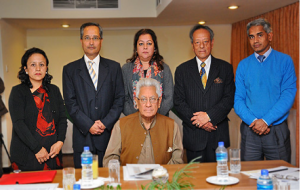Blog 3: Most effective Leadership & Management Styles & approaches in Hospitality and Tourism Industry
For several decades, studies have created various methods of determining the ideal leadership and management styles. Leadership and management are two very different aspects, yet they have certain areas of commonality. Mullins (2013) suggested that leadership is about how a leader is capable of influencing, inspiring and motivating his or her followers, whereas the management is a group of individuals who work towards getting the task done. As stated by Parker and Ritson (2005) suggested that leaders are unique in their own ways, and often an individual is capable of being a leader because the method that he or she has implemented in that particular setting is sufficient to meet the requirements. Mullins (2013) also suggested that a management staff or a manager per say, would have different job responsibilities compared to a leader. I believe that if a leader decides to engage in the management position, he or she might not be able to be as effective, since the rules and protocols, including the processes are not the same. Similarly, putting a management individual to become a leader might have a similar implication, consider that that particular management individual might not have the leadership attributes and qualities to lead people. Therefore, it can be understood that managing and leading people are not the same thing.
What makes leaders and managers ultimately different and similar? Firstly, leaders are more of a people oriented, as it involves influencing and motivating, whereas managers are often task oriented assigned by the upper management or the owners (Kotler, 1990). Secondly, leaders and managers can both be task or people oriented, and that is where transformational and transactional leadership approaches are noted. Therefore, even a manager is capable of being a leader and vice versa.
When discussing the best personal style that managers should adopt to ensure success, there is vast amount of literature suggesting one and the other. I believe that an effective leader should not only be aware of the style that they use and its relevant impact, but they should also be aware of the level and type of relationship that is required to maintain a harmonic yet motivated group of followers. Pitt and Wise (2010) suggested that charismatic leader are very effective in the present day world, due to their ability to charm and motivate people. Bardham et al., (2012) suggested that a leader that is technology oriented is important in the 21st century to stay up-to-date with the followers. Other researchers such as Prasad and Mills (1996), Yukl (2010) and Kotler (2008) have mentioned transformation, transactional, Laisse Faire and other forms of leaderships that are used in varying context. However, I believe that all of these leadership styles are not effective considering the present-day context of our business and competitive world.
I believe that the best leadership technique is the one who embraces a situational leadership technique (Figure 1). Leadership style is how an individual behaves and performs when he or she is trying to influence someone, often in an organizational context, it’s the followers. There are two types of behaviors that a situational leader can have, that is directive and supportive. Directive, is often seen as the push style of leading, whereas supporting is the pull style. I can gladly say that situational leadership is the best technique for the present day world, however which one is best within the situation leadership, that is, push or pull, that I cannot be certain and nobody can as well.
Figure 1. Situational leadership Model
Source: Beyond Theory, 2015
In the case of tourism and hospitality industry, it is very important that leaders and management take a rather push approach. The reason is because, customer service is an absolutely requirement for staffs and followers in the hospitality and tourism industry. Therefore, there should be a directive behavior in what the followers should do and should not do in terms of dealing with consumers. One good example of this form of leadership can be noted by Mr. Dinesh Bista (Figure 2), the CEO of Soaltee Crowne Plaza Hotel (Figure 3), and the only 5 star hotel in Nepal. He suggested that when it comes to dealing with followers and subordinates, we need to push them, tear them and ultimately shape them into the person that is best suited for the industry. He stated “the industry would not change and adapt you, you have to change and adapt the industry” (via telephonic conversation).
Figure 2. Mr. Bista Dinesh (second from the left)
Source: Jayanti, 2013
Figure 3. Soaltee Hotel Nepal
Source: Jayanti, 2013
To sum things up, there is no one absolute method of leading or managing people. There is a series of techniques that can be utilized based on the circumstance that suits the organizational culture, objective and the followers. It is ultimately up to the leader to decide, and as a result, it is this decision that places the leaders on the top of the chart, or at the bottom. A good leader is able to flexibly decide his or her approach towards its followers, noticing what is most effective and what is not.
References
Bardham, I., Krishnan, V. V., and Lin, S. (2012). Team Dispersion, Information Technology, and Project Performance. Production and Operation Management Society. [Online]. Available at: http://rady.ucsd.edu/docs/faculty/krishnan2.pdf [30th Aug 2015]
Beyond Theory (2015). Situational Leadership training. [Online]. Available at: http://beyondtheory.co.uk/situational-leadership/ [30th Aug 2015]
Jayanti (2013). About the Trust. Jayanti Memorial Trust. [Online]. Available at: http://www.jmt.org.np/members_and_advisors.html [31st Aug 2015]
Kotter, J. P. (2008). Force for change: How leadership differs from management. New York: Free Press.
Kotter, J. P. (1990) A force for change: How leadership differs from management. New York: Free Press.
Mullins, L. J. (2013) Management and Organisational Behaviour. 10th edn. Harlow: Pearson Higher Education
Parker, L. D., & Ritson, P. A. (2005). Revisiting Fayol: anticipating contemporary management.British Journal of Management, 16(3), 175-194.
Pitts, D. W., and Wise, L. R. (2010). Workforce diversity in the new millennium: Prospects for research. Review of Public Personnel Administration, Volume 30, issue 1, pp. 44–69
Prasad, P., and Mills, A. J. (1997). From showcase to shadow: Understanding the dilemmas of managing workplace diversity. In P. Prasad, A. J. Mills, M. B. Elmes, & A. Prasad (Eds.), Managing the organizational melting pot: Dilemmas of workplace diversity (pp. 3–30). Thousand Oaks: Sage.
Smircich, L., and Morgan, G. (1982). Leadership: The management of meaning. Journal of Applied Behavioral Science. 18(3), pp. 257-273.
Yukl, G. (2010) Leadership in Organizations. 6th ed. Essex: Pearson-Prentice Hall





Personally, I think you must ask yourself, What type of people do you work with most productively? Because this will reflect to your management style
LikeLiked by 1 person
This is very interesting question and it is also important as it helps me to evaluate myself in term of flexibility of my management style. Personally, I am able to communicate and interact with a variety of people. Also I am able to establish a good working relationships with a diverse group of people. At the same time I feel comfort to be both team players as well as team leader.
LikeLike
Hi Bank, I can see your managing skill from your own experience and group work during university, what I concern is what aspect of your management style would you like to change?
LikeLiked by 1 person
Yes I have some managing skills from my previous work experiences as well as from group work. I believe that no one is perfect, there is always something that need to keep up with the development. In this case I am willing to improve my emotional control.
LikeLike